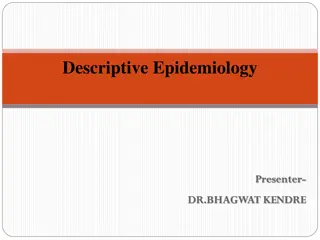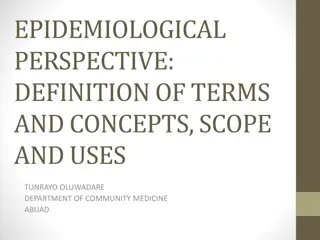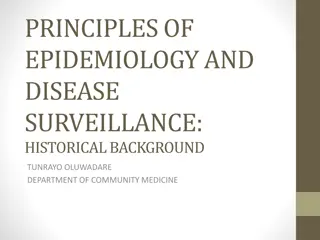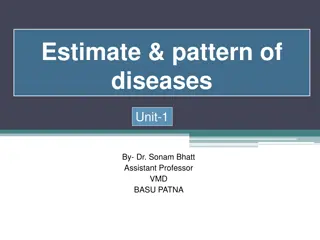Understanding Epidemiology: Disease Distribution and Population Health
Epidemiology is the study of disease distribution in populations, analyzing patterns, determinants, and risk factors to understand and control various health conditions. It encompasses infectious diseases like cholera, nutritional disorders such as scurvy, cancers like childhood leukemia, and non-communicable diseases like heart disease. Through the ecological approach, epidemiology examines how diseases interact with the environment to promote health and prevent illnesses.
Download Presentation

Please find below an Image/Link to download the presentation.
The content on the website is provided AS IS for your information and personal use only. It may not be sold, licensed, or shared on other websites without obtaining consent from the author. Download presentation by click this link. If you encounter any issues during the download, it is possible that the publisher has removed the file from their server.
E N D
Presentation Transcript
Epidemiology & Population Screening 1 Dr. Mayssaa Essam 2020-2021
Disease distribution. Epidemiological methods. Epidemiological data. The uses of epidemiology. Originally, the term epidemiology meant the study of epidemics , but the techniques that were originally used in the study and control of epidemics have also been usefully applied in the study of other types of diseases including noncommunicable diseases and accidents. modern, the term epidemiology refers to the study of the distribution of disease in human populations, against the background of their total environment. It includes a study of the patterns of disease as well as a search for the determinants of disease. It exploits the technologies from other branches microbiology, parasitology, social sciences, etc. in analysing the frequency, distribution and determinants of health and disease in populations.
In genetics and molecular biology have stimulated the development of molecular epidemiology; it investigates the contributions of genetic and environmental risk factors that are identified at the molecular level in the etiology?? and distribution of health and disease in groups and populations. So, modern definition of epidemiology includes three important elements: All diseases included:- The study of infections but it includes cancer, malnutrition, road accidents, and other non-communicable diseases. Populations:- Whereas clinical medicine is concerned with the features of disease in the individual epidemiology deals with the distribution of disease in populations, communities or groups.
Ecological approach:- The frequency and distribution of disease are examined against the background of various conditions in man s total environment physical, biological and social. This is an ecological approach: the occurrence of disease is examined in terms of the interrelationship between human beings and their total environment. The simplest description of epidemiology is that it regards the 'mass phenomena of disease . Epidemiology is the study of health and disease in populations for the purposes of (i) understanding disease dynamics, (ii) controlling disease, and (iii) promoting health Some examples of applications of epidemiology in various types of diseases:- Infectious diseases:- Cholera John Snow in the 1830s showed a strong link between the risk of cholera and the source of water supply.
Nutritional disorders:- Scurvy Classical studies by James Lind, late 18th century, showed scurvy could be treated and prevented by small doses of lemon juice. This finding antedated the discovery of vitamins by over a century. Cancers:- Childhood cancers Studies analyzed risk factors for childhood cancers. One prominent finding was a strong cancers association between abdominal X-rays of pregnant women and leukemia in children. Other conditions:- Heart disease USA showed the association of ischemic heart disease with hypertension, level of serum cholesterol and other risk factors.
DISEASE DISTRIBUTION Three major questions are usually asked in epidemiology:- Who? What is the distribution of the disease in terms of persons? Where? What is the distribution of the disease in terms of place? When? What is the distribution of the disease in terms of time? Answers to these questions provide clues to the factors which determine the occurrence of the disease. Distributions of characteristics of people, e.g., mean age, mean education, mean cholesterol level.
Some of the variables used to describe the distribution of disease in epidemiology:- People :- Age, sex, Race, ethnic group,religion Occupation, education, Personal habits use of alcohol and tobacco. Place :- Country, region, state, district Local community, city wards. Time :-Year, season, day, periodic changes Seasonal variations .
EPIDEMIOLOGICAL METHODS The basic tool of epidemiology is the rate it relates the number of cases to the population at risk. In order to compare populations of different sizes easily, the rate is usually expressed as the number of events in an arbitrary total, for example 1000 or 100 000. There are two main types of rates are calculated. INCIDENCE RATE This indicates the occurrence of new cases within a stated period: Incidence rate=( No.of new cases in started period/population at risk).1000
POINT PREVALENCE RATE This is the number of cases that are present within the population at a particular point in time:- PREVALENCE RATE=( No.of current cases at aspecific time/population at risk).1000 Error All measurement involves error. Science seeks to minimize error and to quantify it as a guide to interpreting data. Sources of error include random error (e.g., variability from sampling) and systematic error (e.g., selection bias, information bias).
Analytical epidemiology Two types of study are employed CASE-CONTROL STUDIES case-control studies (also known as retrospective studies or case-history studies), a group of affected persons is compared with a suitably matched control group of non-affected persons. For example, in a study designed to test the hypothesis that cigarette smoking is an important factor in causing lung cancer, a number of patients with this disease (cases) were questioned about their smoking habits. Similar questions were asked of a group of patients who had cancer at other site (controls). This enquiry showed significant differences in the smoking habits of cases compared with controls.
COHORT STUDIES For cohort studies, a group of persons who are exposed to the suspected aetiological agent are compared with matched control subjects who have not been similarly exposed. For example, in a further study on cancer of the lung, a large group of persons were questioned about their smoking habits. During the follow-up period, the incidence rate of cancer of the lung among the smokers (exposed) was compared with the rate among nonsmokers (non-exposed).
Compared with cohort studies, case-control studies have the advantage of being relatively quick, easy and relatively inexpensive. A significant number of cases can be assembled for the case- history study and a variety of hypotheses can be rapidly screened.
EPIDEMIOLOGICAL DATA As in clinical medicine, epidemiological data may be obtained in the form of answers to questions, physical examination of persons and results of laboratory and special investigations. The value of a particular method the following qualities should be considered: 1- Sensitivity. 2- Specificity. 3- Repeatability. The variation which occurs on repeating the test may be due to the following: variation in the item being measured, for example changes in heart rate, blood pressure and other physiological variables during exercise; limitation in the accuracy of the instrument of measurement.
THE USES OF EPIDEMIOLOGY Epidemiology is a powerful tool of proven value in public health practice. The epidemiological approach should be more extensively used in defining and solving health problems in developing countries. Specialist epidemiologists have an important role in planning and managing the epidemiological services at district and national level, for designing and executing major epidemiological studies, for tackling difficult problems and for training personnel.
At the primary health care unit epidemiological methods should be used to determine the most common causes of death, disease and disability; to find out which persons are at highest risk; and to identify the determinant factors. Epidemiological methods should also be used to solve specific health problems. If, for example, data show that acute diarrhoeal diseases are among the commonest causes of death in a rural district, the most appropriate interventions can best be designed on the basis of epidemiological analyses of the problem.
REFERENCES Rowitz, Louis. 2008. Public Health Leadership: Putting Principles into Practice. A d e t o k u n b o O . L u c a s&H e r b e r t M . G i l l e s. 2003. Short Textbook of Public Health Medicine For the Tropics 4th edition Epidemiology is fundamentally engaged in the broader quest for social justice and equality.

























